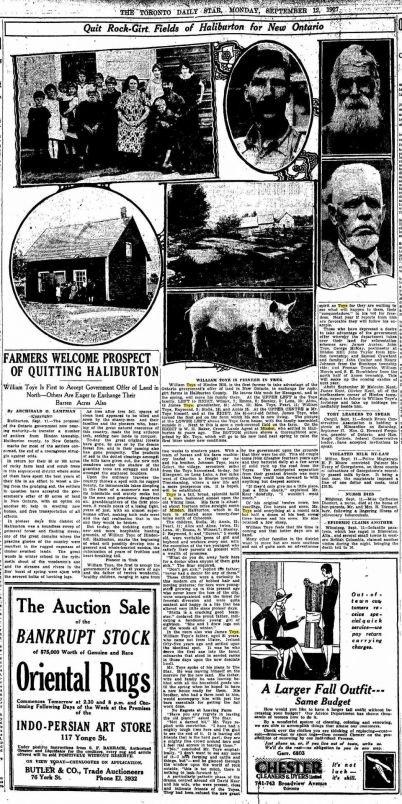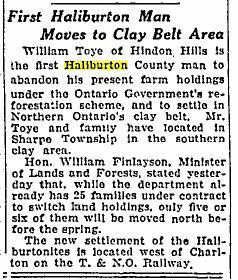Hindon Hill Settlement Area
Location: Hwy 118 and Bobcaygeon Road area. Lot 2, Conc. A, Hindon
Interesting Facts:
Hindon Township's only settlement Hindon Hill, which boasted an Orange Hall, lay on the west side of the Bobcaygeon Road about 10 miles north of Minden. Actually, a number of those claiming it as residence, lived across the Bobcaygeon Road in Stanhope Township. The nature of its terrain which was more suited to hunting and trapping than agriculture limited its population. In 1971 Anson and Hindon had a combined population of 515,
Since only a fraction of Hindon Township drained to the Gull River waters, it did not attract the pine loggers as did Anson and Minden. Since Hindon's soil, even along the Bobcaygeon Road and Brady's Lake, was not suited for agriculture, the land deteriorated until the Ontario government formulated a scheme in 1927 by which Hindon farmers were to be transported to the New Ontario clay belt; the abandoned fields were to be reforested. Source: In Quest of Yesterday by Nila Reynolds. Published by The Provisional County of Haliburton, Minden, Ontario 1973 pg 282-3
Read A Guided Tour of Hindon History, by Susan Wilson, Minden Times 4 August 1990. In this interview Morley Kent (grandson of William Francis Kent, Sr.) told Susan Wilson:
"The psychological, if not the geographical, centre of Hindon Township was the community of Hindon Hill which straddled the road about halfway between the Peterson Road and Ten Hill. There was the Orange Lodge, a post office at the Taylor's farm, with a little red, one-room school house. Because it was on the Stanhope side of the Bobcaygeon Road, it was known as S. S. No. 9, Stanhope.
From Hindon Township, The Times, May 20, 1985. Material taken from the publication "A brief History of names in the County of Haliburton", written by R. J. Baker.
Hindon Township was surveyed in 1860 and takes its name from the old town of Hindon in Wiltshire. Only a small portion of this township is settled. A lumbering firm purchased the timber limits of the township and refused to allow settlement. Hindon Hill Post Office is situated some ten miles north of Minden Village. In 1937 the Ontario Government transferred two or three families from this township to Northern Ontario, where they were settled on the "Clay Belt", at the expense of the Government. The lands thus vacated in Hindon are being held for reforestation.
Hindon Hill (drowning tragedy) From Ontario Abandoned Places:
- This is a ghost community on Brady Lake Rd about 1 km north of Hwy 118. This was once part of the Bobcaygeon Rd. , north of the Peterson Rd., in the 1860's. This road continued north of Hindon Hill along the Hindon/Stanhope boundary line, but has become both impassible and reclaimed by the forests and swamps a few kms north of where Brady Lake Rd and Rugged Lane meet. Rugged Lane is the Bobcaygeon Rd. It continues northward to the top of Brady Lake. A trail on the east side of Rugged Lane up by the cottages there is also the old Bobcaygeon Road.
- The first white man in the area was James Austin Sr. who walked 300 miles from London, ON to take land on Brady Lake. By summer he cleared his lot for next years crop. By fall he walked back to London then returned the next season. His descendants still live in the region.
- By 1862 Dan Taylor (from Ireland) founded the post office. He had 2 children from his 1st marriage and 12 from his second. Before the post office opened the locals (names like: Wright, Crawford, Coulter, Dawson, Armstrong, Guin, Gannon, Stevens and Taylor) had to travel to Peterson Corners for their mail.
- Dan Taylor had a feud with a local named Johnny Boyd. Boyd recited a poem in anger, "Dan Taylor's is blood we'll spill. When we post our letters at Hindon Hill." Dan lived until age 93 luckily. Dan also offered travel by horse and buggy. One famed story involved a lady he was transporting who lost her hat and wig during a sudden stop. Nobody had known this lady was bald.
- At the same time as the post office opening there was a school at Brady's Lake. 3 of its students, Rachel and Barbara Coulter, and a Gannon boy, found a canoe with a leak in it and took it out on the lake. All three drowned.
- A church existed, but little is known about it. There was also an Orange Hall on west side of the Bobcaygeon Rd.
- Most of the community lived on the Stanhope Township side of the road (the east side). By 1890 names like Bull, Fuller, Coulter, Pearl, Stevens and Wright still existed here. Lumber camps were in the region too and kept some of the pioneers busy with work.
- Baseball was very popular here and throughout all of Haliburton in the late 1800's. The Hindon Hill team would gather after long days on the farm and practice or play other communities in the county.
- Liquor consumption was common. One story tells of a local who was a prolific producer of the fire water called potcheen. When he died his teeth had no cavities due to the germ-killing qualities of his potion.
- As the soils became depleted and the population declined a Dr. Nesbitt of Lindsay started a muskrat farm here. It was managed by Swan Ackerblade.
- The final blow to the community came in 1927 when the Ontario government decided to evacuate the bush farmers to greener pastures in the clay belt and to refill their lots with trees. Livestock were driven from the barns and were driven with the farmers to the Gelert train station and then northward by train. The farmers included: Hewitt, Toye, Trumbull and Kent.
- James Austin Sr. and Jr. continued living at Brady's Lake. In 1937 it was reported that they had shot 8 wolves here.A few buildings (collapsed and such) and foundations remain.
Image 1. Toye Family Newspaper Article. Toronto Star 1927

September 14 1927 William Toye Globe & Mail.